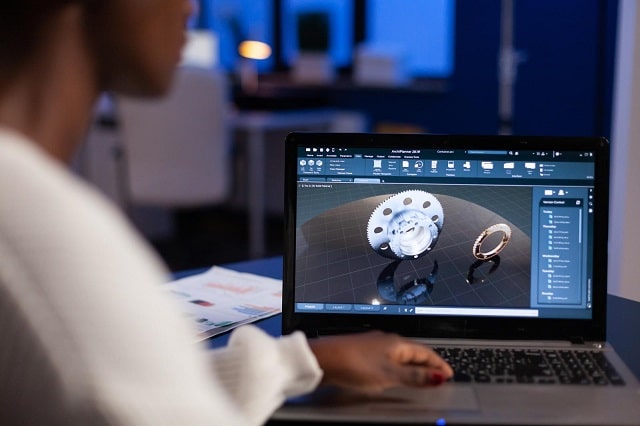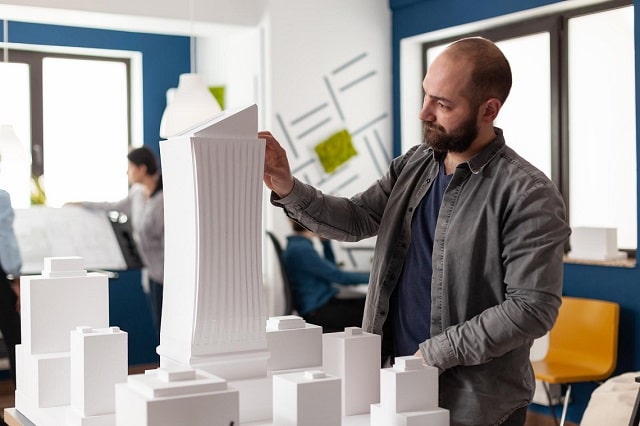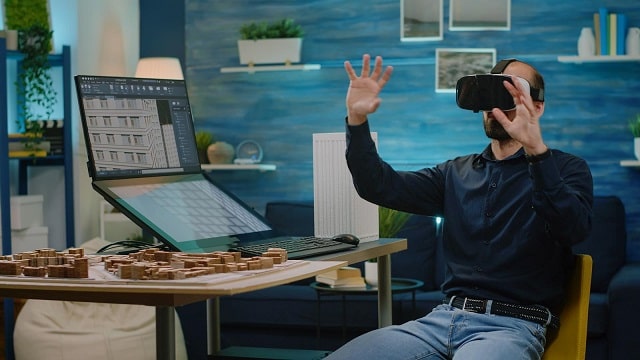Technology is downstream of science, and engineering is downstream of technology; it’s the application of technology to solve specific problems. This has been articulated in our previous article on the engineering design process. In this article, we’ll take a deeper dive into:

The application of technological solutions to specific situations is called engineering. To design and build a suitable solution for a problem, all the constraints and resources have to be considered. The engineering design process describes the process of using engineering knowledge and technology to build solutions to specific problems.
For example, the construction of a house is an engineering design process problem for contractors and architects. There are many constraints to building a house. Some of the common constraints and requirements include:
A civil engineer has to work within the constraints of the project while also meeting the client’s requirements. By following the engineering design process, the engineer takes all variables into account and finds solutions to them before construction begins. Commercial trucking is another example of solutions developed through the engineering design process.
Every engineer needs to follow a set of structured steps to solve specific engineering problems. We’ll take a closer look at these steps in the next section.

The engineering design process lays out a standard set of steps that any engineering design problem has to go through to arrive at the best solution. These steps are a starting point or basic template that you can modify and add or subtract steps as needed to suit your environment or the specific problem at hand. Following this process enables engineers to build robust engineering solutions to challenging problems.
There are several variations of the steps involved in the engineering design process. Some models have fewer or more steps, but in general, the process follows a similar sequence regardless of how the steps are broken down.
Below, we’ll take a closer look at each step in a 9-step framework.
To engineer a solution, you need to define the problem first. Failing to complete this step properly can stall your projects later in the process. Once you try to define a problem, the specifics of the problem start coming up, giving more clarity and insight into the design problem. In most instances, a solution naturally emerges when you define the problem really well.
Engineering problems arise from the needs of the customer or end-user. Multiple resources will be required to satisfy the need and complete the design process. These resources (such as more information or specific materials) must be identified before designing a solution.
You also need to identify the project’s constraints, which may include financial, legal, technical, or personal constraints. For instance, products subject to military specifications may be required to use certain materials or meet other compliance requirements. Available resources and constraints are the yin and yang of engineering design problems. Together, they compose the project requirements. Once you’ve identified the specifics of available resources and constraints, you can move on to the next step.
The next step in the engineering design process is to brainstorm solutions. Brainstorming shouldn’t be done in isolation; involving employees, industry experts, and experienced professionals can help to spark ideas and possibilities from different perspectives. Depending on the industry, consultants also can be brought in to brainstorm solutions. Once this step is complete, you will have a roster of potential solutions to the problem at hand.
After identifying the available resources and constraints of a well-defined problem, brainstorming takes place, and multiple solutions often arise. Each of these solutions will have its own upsides and downsides, so the next step is to evaluate all potential options and choose the best solution. You can use various methods to eliminate the less viable solutions (such as a decision matrix), leaving you with the most appropriate solution for the problem. Only after deciding on the ideal solution can you proceed with the next step in the engineering design process.
Before directly implementing the solution, you have to build a prototype. The main advantage of a prototype is that it is isolated from the rest of the system or environment, minimizing any consequences of a failed experiment. Engineers should always account for the worst-case scenario while going through the engineering design process.
The next step after building a prototype is testing it. The solution’s viability can be established only after it undergoes a battery of tests covering normal operating conditions as well as in high-stress conditions. For example, HVAC engineers can use CFD modeling in HVAC designs can simulate various operating conditions and analyze the impact on the building or outdoor environment. The testing phase is a crucial part of the engineering design process, as it’s often the stage at which what was once believed to be the ideal solution isn’t a functional way to solve the problem at hand.
If the prototype does not meet expectations, you need to go back to the drawing board. First, you have to determine whether some elements were lacking in the problem definition. You also need to check if you had any wrong assumptions or estimates while determining the available resources and constraints, and then you can proceed to select a solution from the alternatives identified in step three (brainstorming). Once an alternative solution is selected, you’ll work through the subsequent steps of building a prototype and testing it. This process continues in a loop until a prototype is developed that meets requirements and performs adequately in normal and high-stress operating conditions.
Once a viable solution is found, it’s no longer necessary to iterate through the aforementioned steps. At this juncture, you’ll communicate the results of the engineering design process to the respective stakeholders in your company. These stakeholders may include managers, engineers, the board of directors, shareholders, local communities, etc. State and federal governments may also have to be included depending on whether the project is subject to regulatory requirements or approvals. During this step, you’ll also get the permissions required from various stakeholders to proceed with the project.
After obtaining all necessary approvals, you can start building the solution. As the engineering design aspects of the project are complete, this is the last step in the engineering design process. Subsequent steps from this point forward are considered operational elements of the engineering process.

At its core, the engineering design process is a project management problem and uses many of the same tools. The following sections cover the most popular tools used in the engineering design process. These tools – as are any tools – are meant to support and streamline processes; tools should never become the masters of the process.
A dashboard gives an overview of the current status of the engineering design project and where it’s headed. A central source of information on the stages of the process, who is responsible for various tasks, and what tasks are currently in progress or awaiting further information, a project dashboard is a valuable tool to manage the engineering design process. Many project management solutions include a central dashboard to provide a bird’s-eye view of the project progress and next steps on the roadmap. These software solutions typically also include features such as the ability to assign tasks, set deadlines, and collaborate with team members throughout the design process.
Many project management solutions offer various views to allow each user to view the project in the format they find most intuitive. A Gantt chart is a type of bar chart featuring horizontal bars that indicate the progress of a project and its components. Henry Gantt designed the first Gantt chart in the early 20th century. As time is a critical element of the Gantt chart, it displays activities, tasks, or events against a timeline, making it suitable for time-sensitive projects.
The left side of a Gantt chart has a list of activities. The time scale is represented at the top of the chart. Each bar in the chart represents the duration of the activities across various dates. Gantt charts can also represent the chronological order in which activities have to be performed.
Another methodology for viewing and managing projects, Kanban boards help to visualize the workflow and maximize efficiency. Classified as an agile project management tool, they also help to limit work-in-progress. (Agile project management applied to engineering is also called agile engineering.) Kanban boards use columns and cards that can be moved from column to column, with the columns representing the status of a task, the responsible party, or any other organizational classification that makes sense for the project. Useful for continuous improvement in the engineering design process, Kanban boards also can be used to manage multiple projects from a single dashboard.
WBS breaks down the whole engineering design process into smaller, more manageable elements. These elements are then placed on a board in a hierarchical structure. Breaking work into smaller components is a psychological hack that can be used to encourage continuous progress in any project. Time also plays a major role in designing the WBS, yet it is not the best tool for managing time-sensitive projects.
Waterfall project management is a project management methodology that emphasizes the chronological order in which tasks have to be performed. It follows a linear progression from the start to the end of the engineering design process, and each new phase can only be started after the previous phases are complete. The major disadvantage of this approach is that all planning and estimation must be complete before the project begins. There is limited flexibility after a project has commenced in the waterfall model.
The various steps in the engineering design process take varying amounts of time, and they also have an order in which they have to be performed. These tasks also have some level of dependency on each other. In such instances, a critical path methodology can be used to manage the engineering design project. To use the CPM, you first need to identify the largest group of dependent activities, measuring the time needed to complete them from start to finish. Then, you can determine which activities have the longest path, allowing you to begin with those activities and postpone non-critical tasks without slowing down the project’s progress.
A project baseline is the starting point for any project, consisting of a detailed account of the various project milestones, completion deadlines or scheduled time for each milestone, the estimated number of hours or days to complete each milestone, and the costs associated with completing each milestone. Your project baseline then serves as a point of reference that you can compare against your actual project progress over time to determine if the project is on-track. A project baseline is also useful for sharing more specific details and setting expectations with shareholders, particularly if you’re in the process of obtaining approval to move forward.
Most transformations in organizations fail due to a lack of employee participation. Businesses too often take a top-down approach to process improvements, which can create friction between management and the rest of the team. For implementing any change in an organization, employee participation is key.
Employees are the ones who have to build, test, and finalize design prototypes that emerge from the engineering design process. They also should be active participants in the design process too. Front-line employees are often the best source of insights into the specifics of a problem, and they can also provide valuable ideas during brainstorming and other steps in the design process. They can become roadblocks or lubricants for change, making employees a key demographic at every step of the engineering design process.
User-centric design is a common approach across many disciplines today. Whether the end user is an employee or a general consumer, the people who will be using an engineering solution to streamline processes or solve problems will ultimately determine its success or failure. Engineering solutions that are too complex for the end user or introduce new problems that impede progress are unlikely to achieve widespread adoption.
While end users are not always readily available to engage throughout the engineering design process, strategies for engaging end users are being explored across many industries. End users can participate in the engineering design process from the very early stages – providing insight into the problem at hand or the requirements of a solution – as well as in the later stages, such as by testing prototypes in real-world applications and providing feedback.
End user involvement can benefit the engineering design process in several ways, such as:
While end user involvement can be challenging to achieve, there’s no denying that it helps to improve the design process and the products created through it.
The application of technology to solve specific problems falls under the purview of engineering. Engineers need to know the resources available and the constraints under which they have to operate to design and build functional solutions. After defining the problem as well as those constraints and resources, the brainstorming process produces several ways to tackle the problem.
Prototypes built based on the most viable solution must be tested rigorously to evaluate performance in various conditions – preferably with end user involvement. The cycle of iterating on these steps is the hallmark of the engineering design process and the method by which today’s most innovative products are created.
Our sales engineers are experts in automatic asset tracking, tagging and identification,a nd can answer all your questions. Get in touch now.
Lets Talk ›